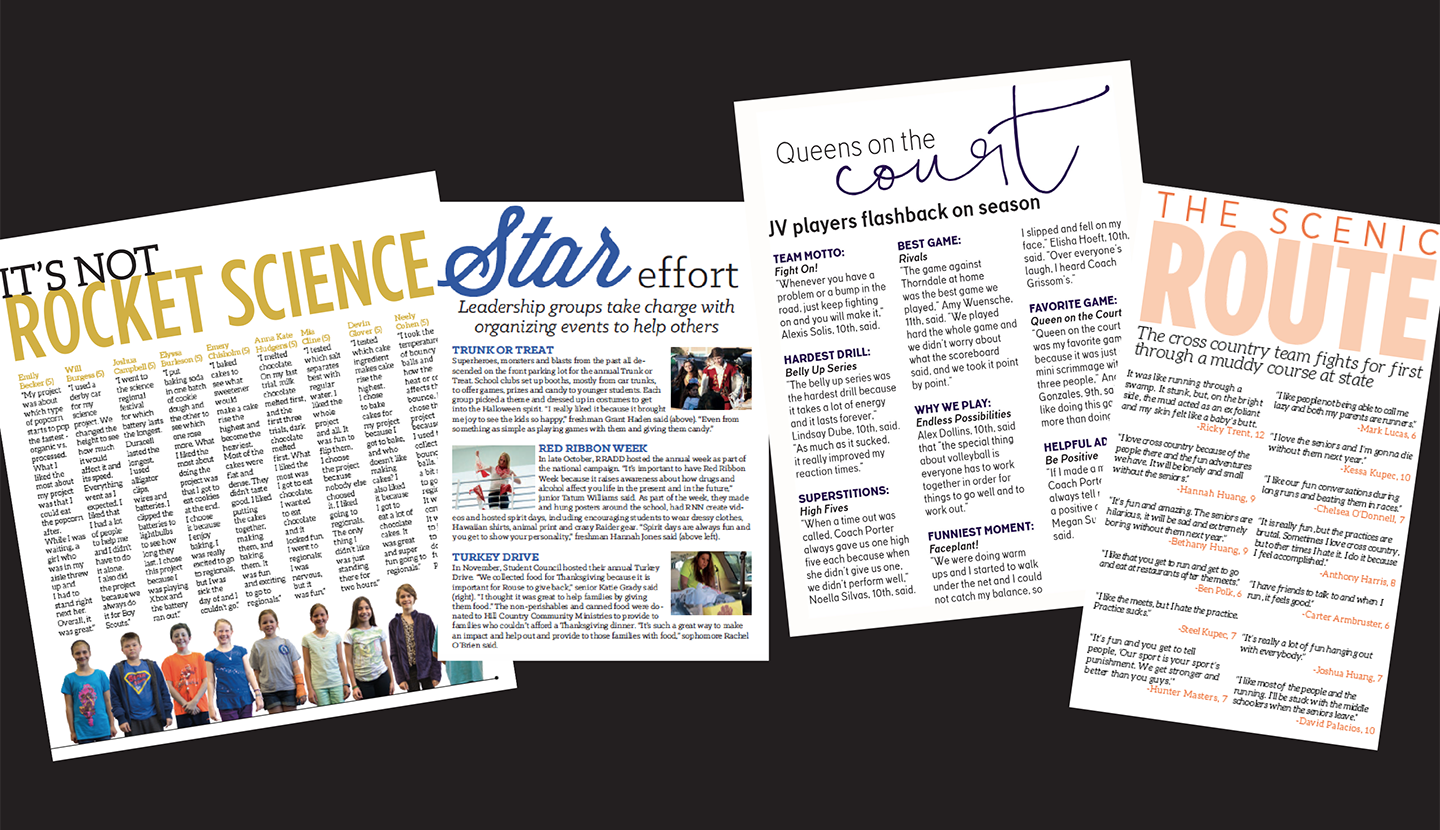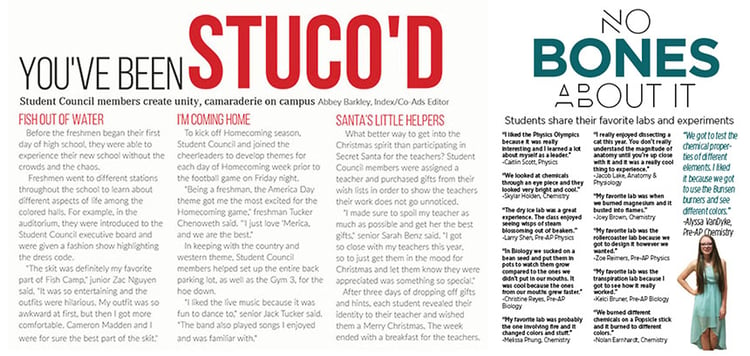
Body copy. Text. Anecdotes. Narratives. Features. Stories. If you dread the writing aspect of yearbook, we’ve got a suggestion to make you love words again.
Stories can be one of the more difficult parts of completing a yearbook. Students struggle with gathering enough information, getting meaningful quotes and organizing the story. It often feels like they’re just trying to fill space. And let’s be honest, stories are the least read element of a yearbook spread. All that time and effort devoted to the story isn’t always appreciated.
So, what’s the alternative?
Solve the story problem by changing the format. Replace the story with a different option in the copy block – what we call alternative copy. It could be a Q&A, checklist, mini-stories or a series of quotes. The alternative fits where the story would have been, but provides a different way of covering the topic.
What’s the benefit?
- It’s practical. Compiling a Q&A is less stressful than putting together a whole story, especially for struggling writers. Writing mini-stories of five to 10 sentences is more manageable than writing a 300- to 800-word feature. Keep in mind, easier doesn’t necessarily mean less work. Staffers still have to conduct strong interviews and gather meaningful information and quotes.
- It’s more inviting. Long columns of text tend to discourage students from reading the story. But short, quick reads are more inviting. Students can get in and out of the copy easily, or they can choose to read only parts of the alternative text.
- It’s prettier. Running alternative copy gives staffers a chance to play up the design. Students can add bold or italic weights of fonts to provide contrast. They can add a pop of color by putting subheadlines or names in a hue featured on the page. Plus, the different design is a welcome change for the reader. Seeing story after story makes students less inclined to look closer. But a change in the design can bring that interest back to the page. Substituting alternative copy for the story allows the layout to get a needed change-up without designing a whole new spread.
- It’s more inclusive. Stories tend to have one to three students quoted in them. But alternative coverage gives an opportunity to include more people. A Q&A could have answers from multiple students, ranging from three to 12 subjects. Depending on the story space, a quote package could feature up to 15 or 20 students. Mini-stories provide a way to feature multiple classes, clubs or sports in the story space instead of just one group. If you’re looking for a simple way to include more students in the book, alternative copy is a smart solution.

What are the options?
Just like with secondary coverage and sidebars, there are a lot of options for replacing the story with alternative copy. Some of the most popular options include:
Mini-stories: These are miniature versions of feature stories. They follow the quote transition formula, but on a much smaller scale. Minis usually include five to 10 sentences and one to two quotes. Utilizing mini-stories gives younger writers a chance to learn feature writing without being overwhelmed by the magnitude of a whole story. Writing mini-stories can help reporters learn the format and gain confidence for writing longer stories. Mini-stories are also a great way to feature multiple events, topics or games. A sports spread on a team advancing deep into the playoffs would benefit from mini-stories on each game. Similarly, groups sharing space will benefit from running mini-stories instead of one long one. Leadership clubs like Student Council, National Honor Society and Key Club might need to share a spread, but they could see each of their volunteer events covered with short stories. When multiple clubs, classes or sports run on the same spread, mini-stories allow each group to have representation.
Q&As: Question and answer formats provide an alternative to traditional stories and a simpler option for struggling writers. Q&As should include at least three questions and relate to events that happened. Increase coverage by interviewing athletes, club members or students who didn’t make the spread in photos or sidebars. Instead of only interviewing one to three students and asking them multiple questions, consider interviewing multiple students for each question (Save the limited interviews for a sidebar package). This allows for a wide variety of answers and more students to be include in the book. For example, if you asked four questions and featured three different answers, 12 students would be covered. Also, Q&As are a great way to find out details readers would otherwise be unaware of. Asking about a pre- or post-game ritual, funniest thing that happened in the locker room or bonding moment can be an unexpected insight into a team. Just remember to focus on the current year and avoid questions or answers that look forward to next year.
Quotes: One of our favorite options for alternative coverage, quotes are a fantastic way to include a lot of students. The quotes should focus on one topic, using the secondary headline to introduce the subject. They could range from short, one sentence answers, to two or three sentence responses, to lengthy, detailed anecdotes (see first-person stories up next). Depending on quote length, up to 20 answers could fit in a story space. This is an ideal option for groups with large memberships like band or football. Like Q&As, quotes provide an inner look at unfamiliar programs, events, clubs and sports.
First-person anecdotes: First-person stories are a mash-up of mini-stories and quotes, providing more of a storytelling feel. Anecdotes allow the interviewee to tell a story with more details and length than a typical quote. The first-person perspective puts everything in the subject’s words and removes the need for leads or transitions. This is a good option for younger staffs as well as themes that emphasize the individual.
Sports wrap-up: This alternative copy is an ideal for sub-varsity sports coverage when it’s difficult to write a long story about a freshman or junior varsity team. Wrap-ups also provide a useful option when smaller and sub-varsity teams share space. They come in a variety of formats, but essentially sports wrap-ups provide information about the season in small chunks. They should include the overall and district/conference record, the best game, season highlight/s, and thoughts from coaches or players. It’s helpful to use bold, colored subheads and to leave space between each element.
Bullet points: A lesser used option, bullet points provide a way to tell the story in a simple manner. This format allows the writer to highlight the important facts and details without losing them in the depth of a story. Bullet point stories are a fun way to cover statistics for academic classes, clubs and sports. For example, a leadership spread could include bullet points on students in leadership clubs, hours spent volunteering, money raised, cans collected, etc. Consider including a few quotes with some of the bullet points to add reactions and thoughts, a human connection to the factual information.


So, now what?
Look back at your designed spreads and decide where it would be beneficial to switch out the traditional story for alternative copy. Would it be easier to use a Q&A, quotes or first-person anecdotes? Consider swapping a long story for mini-stories, especially on pages where clubs or teams share space. Try substituting sports wrap-ups for freshman or JV coverage. A feature isn’t always the best way to tell a story.
But a word of caution: don’t delete all of your traditional stories. In some cases, a feature is the best way to tell the story. Some stories deserve the space for detailed information and quotes. A huge accomplishment during the year, like a sports team or individual winning a state championship, is ample reason to write a feature story. Think strategically about what format will best suit the spread and benefit the staff.
Alternative copy is an innovative way to ease story anxiety, draw in readers, improve the design and increase coverage. That’s a happy alternative we can live with.

